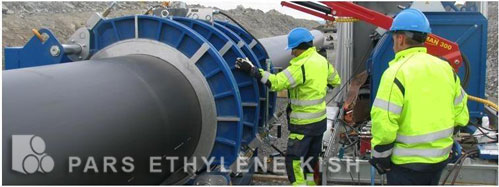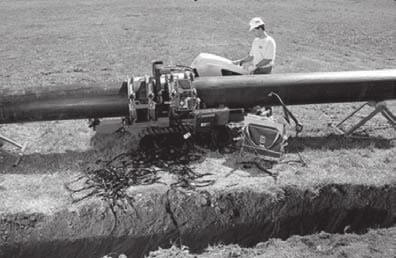
Repair of polyethylene pipe and fittings
The method of repairing damaged PE pipe depends upon the degree of damage sustained. Localised damage may be repaired by use of an electrofusion saddle or clamp fixed around the damaged area. Such a repair may not be suitable where gas or other flammable fluid is present in the pipe, due to the heat generated in the fusion process. PE encapsulation techniques have recently been developed and may be suitable for localised repairs. Information on these techniques can be obtained from the pipe manufacturers.
More extensive damage will require the section of pipe to be cut out and replaced. This is a relatively simple process, firstly isolating the damaged section by the use of squeeze-off tools, cutting out the section and replacing with new pipe using electrofusion couplers to tie-in the sections. It is important that the replacement section is of suitable diameter and pressure rating to maintain the integrity of the pipeline.
polyethylene pipe comes in very long rolls and is used in many areas for the water main between the meter and the house. Just like any other type of pipe poly pipe does not last forever and can develop leaks with time and with the help of tree roots. As roots grow they push against the pipe and eventually break it.
Repairs in this type of pipe can be difficult if it is installed deep in the ground and the hole is not big enough to allow for plenty of pipe movement. Locating the source of the leak can also be difficult. Sometimes you will be able to locate the problem by digging up the wet area in your yard. You may not always get so lucky and the wet spot will be a long way from the actual leak if the water follows a gopher hole or something. Either way, a bit of digging will be involved.
To fix a leaking black polyethylene pipe:
Shut the water off - You don’t want to be bailing water while you are trying to dig. You can always turn the water on if you think you are getting close to the leak. Or turn the water on once the pipe is exposed to see exactly where the leak is at.
Dig carefully - Unless you know about how deep the pipe is located you need to dig carefully so that you don’t end up hitting the pipe. If you know about how deep it is then you can dig the first bit quickly until you get closer. Otherwise, dig slowly. As you get close to the right depth switch to a smaller trenching style shovel if you have one to have more control while digging in the hole. Make sure to expose all the way around and under the pipe to make it easy for you to work. Cut back any roots that may impose on the water line later since you are down there already.
Plan the cut - First double check the location of the leak. It’s important to pinpoint where the leak actually is so that you can decide what fittings you’ll use for the repair(Polyethylene pipe repair fittings). If the leak is at a tee you may be able to loosen the clamps and remove the barbed tee from the pipe so that only one pipe has to be cut. Since you will have only a little room to work with you want to avoid shortening the pipe on more than one side of a fitting if possible. So, decide how best to cut the pipe to make the repair based on where it is located. Then use a pipe cutter to cut the pipe.
Install fittings - Put the clamps onto the pipe before inserting the barbed fittings into the pipe. Insert one end of the fitting into the pipe pushing it in as far as it will go. Use WD-40 or a little liquid soap to lubricate the barbs if you have trouble pushing the fitting in. Then lift both ends of the pipe, line up the other end of the fitting to the opposite pipe and push the fitting into the pipe as you push the pipe down.Tip: It’s a good idea to use two clamps on each side of a fitting for the extra hold. Stagger the clamps so that they pull in different directions.
Tighten the clamps - Slide the hose clamps up so they are positioned over the barbs. Tighten each of the hose clamps with a screwdriver. Make sure the clamps are secure and don’t move around.
Check for leaks - Turn the water on to check for leaks before any backfilling. Sometimes the clamps will need a little extra tightening, so give them plenty of time to be sure they aren’t going to leak before you cover them up. Once you are certain nothing is leaking backfill the dirt being careful to pack the dirt down around the pipe as you go to prevent disturbing the fittings.
General Guidelines for Repairing Buried
PE Potable Water Pressure Pipes
Traditional piping systems have gasket-sealed bell and spigot joints every 20 feet, which can be a potential maintenance and repair point at each connection. Metallic pipes are subject to corrosion which can require constant maintenance over the life of the pipes. A heat fused high density polyethylene (PE) pipeline is not only corrosion and chemical resistant but the leak free joints at 40 to 50 foot intervals are as strong as the pipe itself which provides a maintenance free system except for infrequent unforeseen third party damage. If
PE is damaged by a third party, repair methods may be required
to bring the piping system back into service as soon as possible. This document will provide general guidelines for repairing PE. They should be useful in establishing procedures and/or specifications for various repair methods to PE piping systems.

For above ground repairs, when the pipe can be moved, the damage can be cut out and replacement pipe can be butt fused or electro- fused into the system.
Restraint Methods
Mechanical Repair Fitting Restraint
The most common method of restraining a mechanical repair fitting is to add a back- up flange to each pipe and electro-fuse the appropriate number of Flex Restraints to each end of the mechanical fitting. The number of Flex Restraints fused to each end depends on the pipe diameter (contact the fitting manufacturer for proper assembly instructions). Once the Flex Restraints have been cooled properly, the mechanical components such as the sleeve, glands, gaskets and bolts can be installed per the manufacturer’s procedures to complete the restraining process.